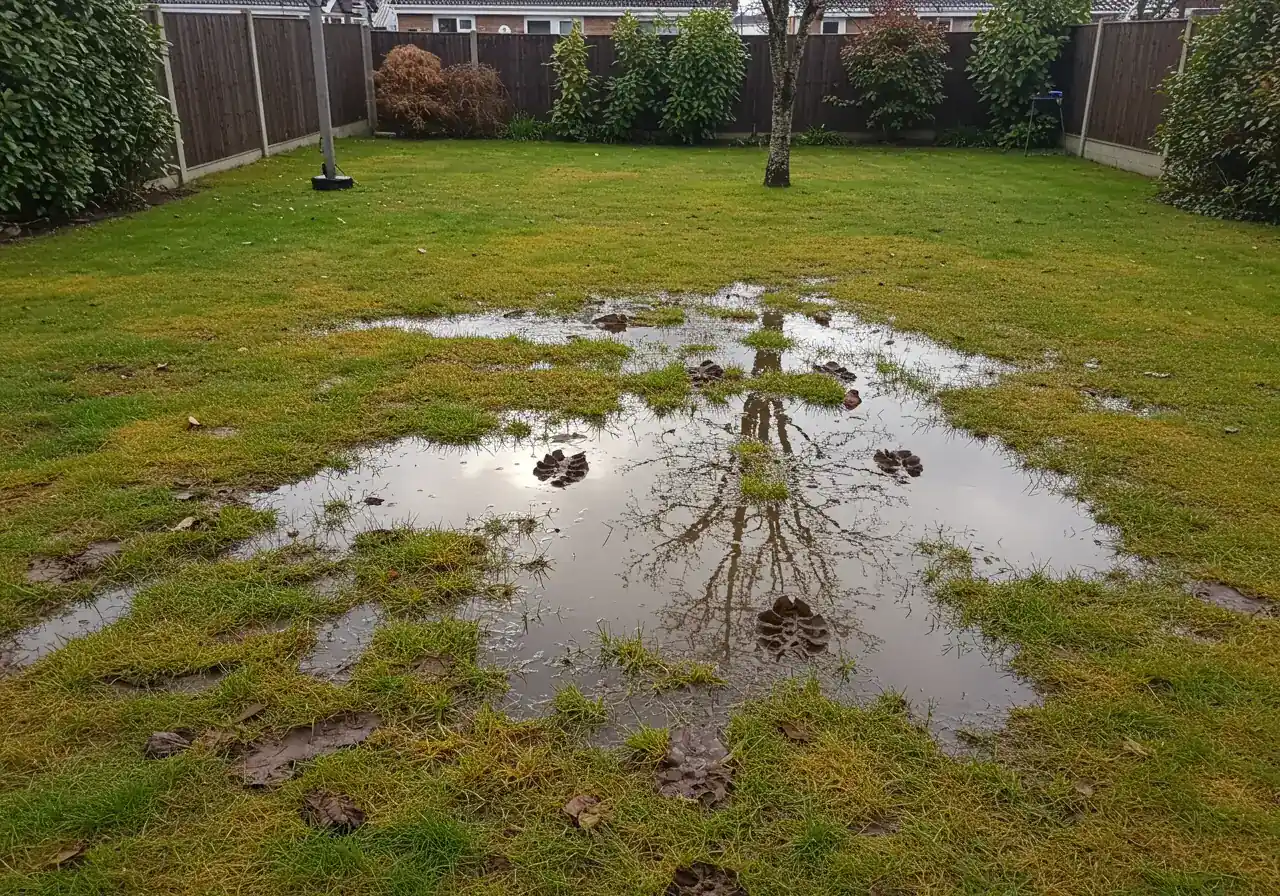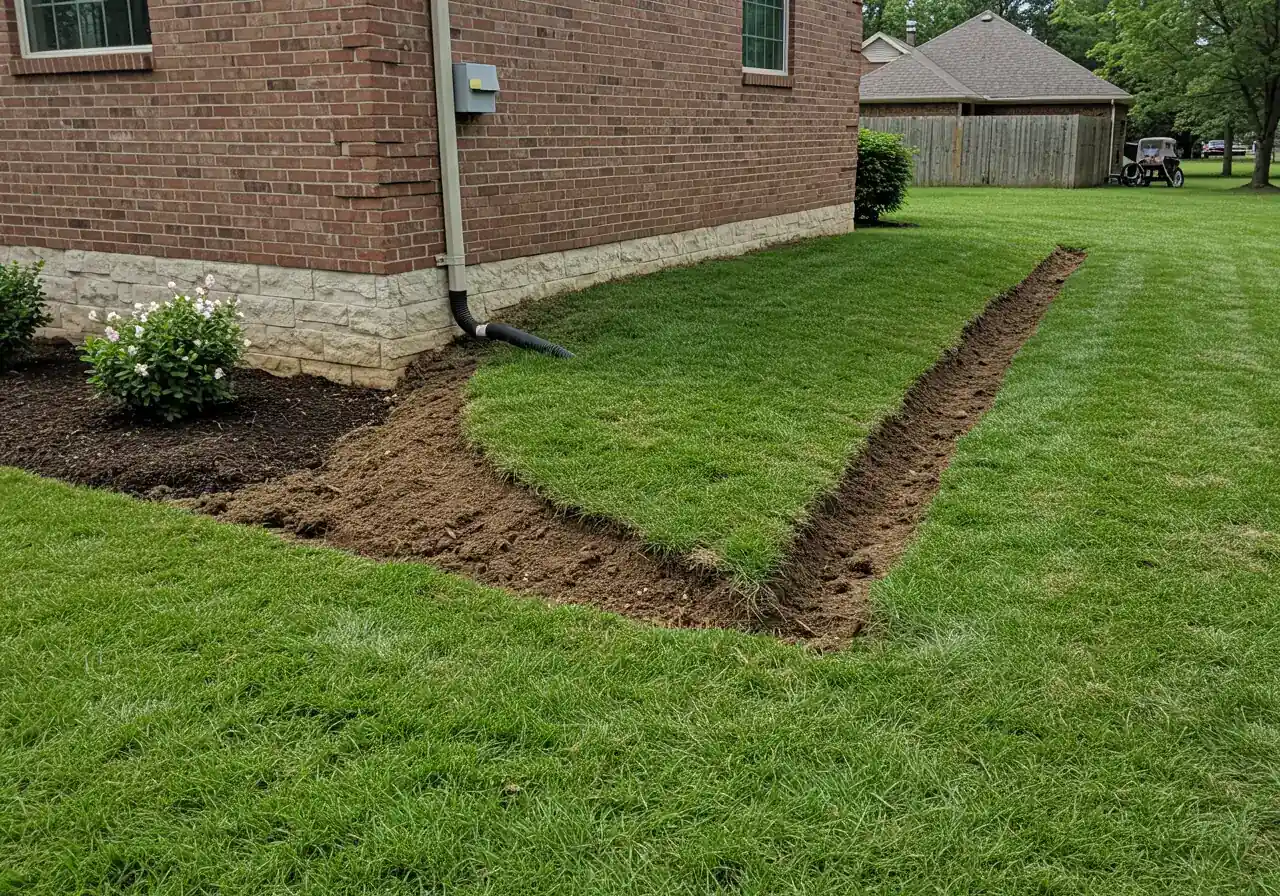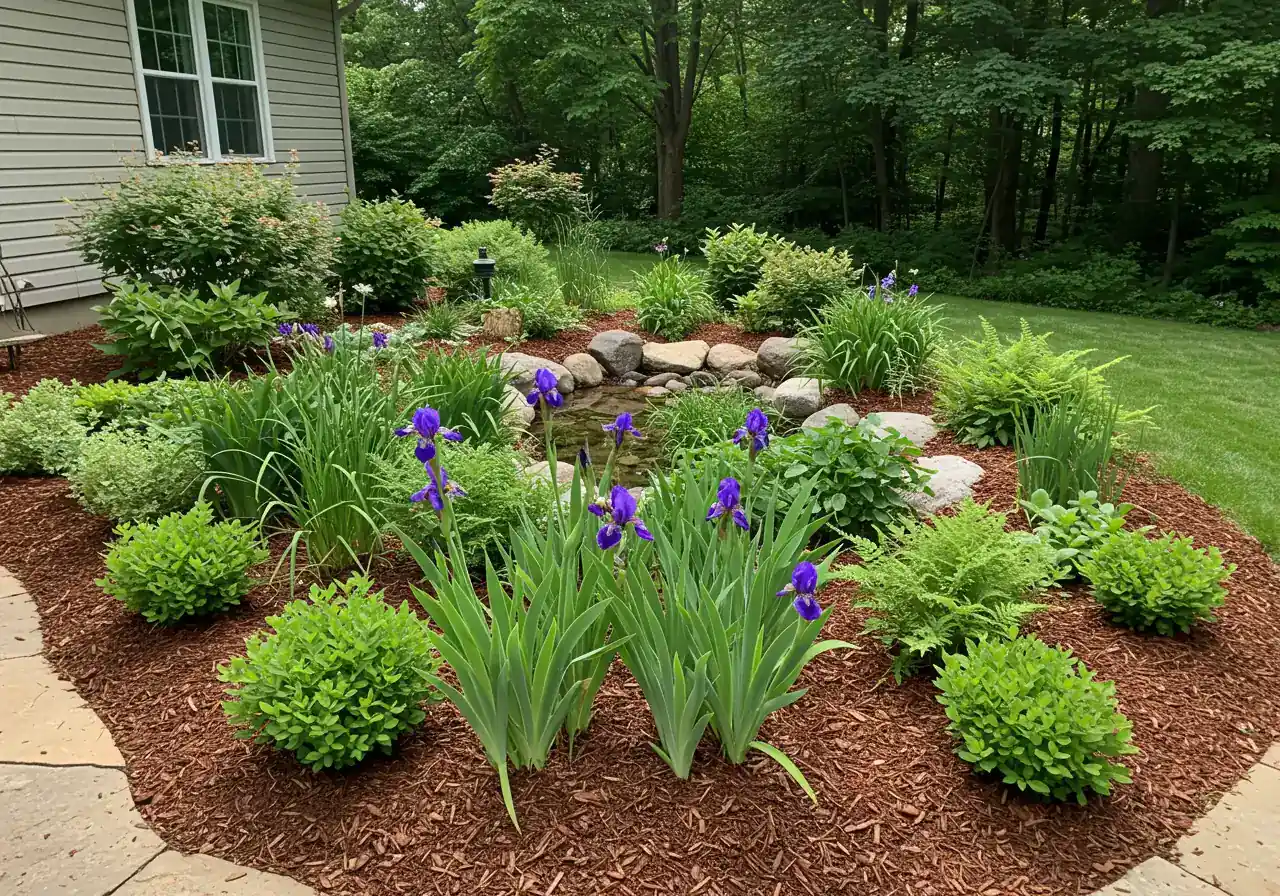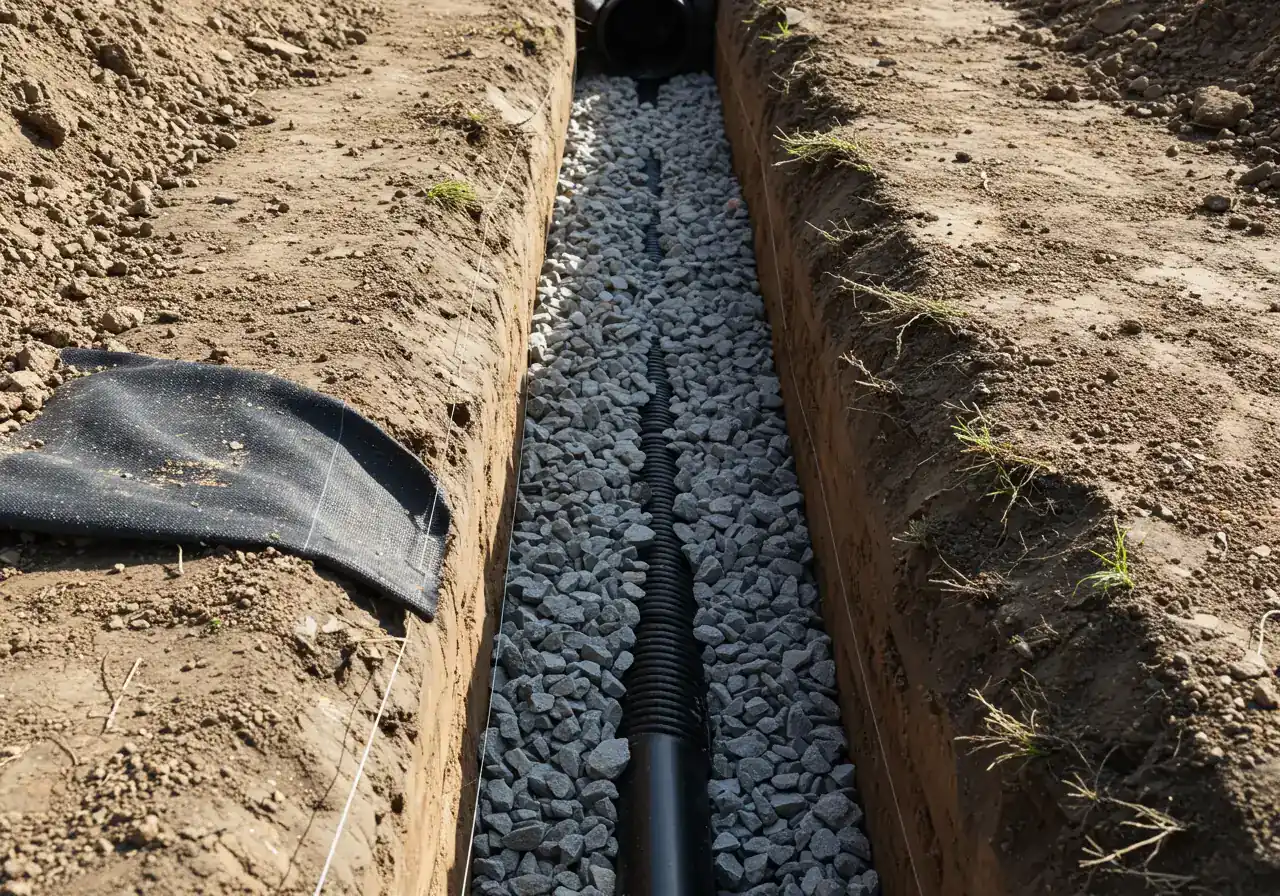“`html
Solve Embrun Drainage Woes: Spring Site Grading Guide
Quick Guide to a Drier Yard:
- Proper site grading directs water away from your house foundation.
- Aim for a gentle slope (e.g., 1/4 inch drop per foot) for the first 10 feet.
- Understand issues like clay soil and compaction common in the Ottawa area.
- Consider drainage boosters like French drains, swales, or rain gardens.
- Always Call Before You Dig (Ontario One Call).
- Protect freshly graded soil with seed, sod, or mulch.
Facing drainage issues in Embrun or the surrounding area? Get a professional assessment!
Request Your Free Quote TodayIntroduction: Say Goodbye to Soggy Lawns in Embrun This Spring!
Ah, springtime in Embrun! The birds are singing, the snow is *finally* melting… and your backyard resembles a small, persistent pond. Sound familiar? If you’re tired of your lawn squishing underfoot or dreaming of gardening without needing hip waders, you’re not alone. That soggy situation isn’t just messy; it can harm your grass and plants. Here in the wider Ottawa region, our lovely freeze-thaw cycles and sometimes heavy soil can make proper water drainage a real challenge, turning potential green spaces into mini marshes from Embrun to Russell.
But fear not, soggy lawn sufferers! There’s a superhero solution called site grading. Think of it as smart landscaping that gently guides water away from your house and off your lawn, telling it exactly where it needs to go (hint: not where you want to set up your patio chairs). This article is your guide to understanding site grading – what it is, why it’s important (especially around here!), and how it can help you finally say goodbye to those puddles and hello to a beautiful, usable yard this spring. Let’s get your lawn ready for sunshine, not swimming!
Decoding Drainage Disasters: Why Embrun Yards Turn into Swamps

So, you’ve noticed your Embrun yard looks more like a wetland habitat than a place for barbecues. What gives? It often feels like our lawns here in the wider Ottawa region are auditioning for the role of “local swamp,” especially after the big spring melt or a heavy downpour. Let’s decode why your green space might be holding onto water like a greedy toddler with a new toy.
One major culprit is our good friend, clay soil. Common in many areas around Ottawa, including parts of Embrun and nearby communities like Russell, clay soil has tiny particles packed tightly together. Think of it like trying to pour water through modeling clay – it doesn’t drain quickly! This means rainwater and snowmelt just sit on top, creating those lovely puddles and squishy zones.
Another factor is compaction. Over time, foot traffic, lawnmowers, and even just the weight of winter snow can squash the soil particles even closer together, squeezing out the air pockets water needs to travel through. This is especially true in established areas like Osgoode, but can also happen surprisingly quickly in newer developments like Barrhaven if the initial site grading wasn’t done quite right or heavy equipment compacted the ground during construction.
What are the tell-tale signs your yard’s drainage is crying for help?
- Persistent Puddles: Water hanging around long after the rain stops.
- Squishy Lawn: Does walking on your grass feel like stepping on a wet sponge?
- Bare Patches or Yellowing Grass: Roots can rot if they sit in water too long. Improving lawn health might involve more than just fertilizer; sometimes topdressing your Manotick lawn: a how-to guide can help improve the soil structure over time.
- Moss Invasion: Moss loves damp, shady spots – a classic sign of poor drainage.
- Water Near Foundation: This is a big red flag! Water pooling near your house can lead to serious foundation issues.
Understanding why the water isn’t moving is the first step. Sometimes, improving the soil itself is key; learning about the best soil mix for Ottawa raised beds can offer insights into creating better draining conditions for your plants. Other times, you might need to actively redirect the water using landscaping techniques. A properly designed swale can work wonders; check out this for ideas. Dealing with soggy gardens often requires extra effort, similar to the work involved in a thorough Russell garden clean up service. While frustrating, you could even embrace a wet spot by learning about , turning a problem area into a feature! If tackling soggy soil and grading feels overwhelming, exploring professional landscaping and drainage services is always a smart option. Check out what our clients say on our Google My Business page!
Site Grading 101: Shaping Up Your Landscape for Better Drainage


Alright, let’s talk about playing in the dirt – but with a purpose! Site grading sounds fancy, but it’s really just about shaping the land around your home so water flows away nicely, instead of creating mini-lakes where you want to put your patio furniture. Think of your yard like a very gentle slide, and rainwater is the kid who needs to get to the bottom without stopping halfway. The goal? Keep that water moving away from your house foundation. Seriously, water pooling near your foundation is like inviting trouble over for a long, expensive stay.
So, how do we shape this “slide”? We use a few key landscaping tricks:
- Slope: This is simply the angle or tilt of your ground. Proper grading ensures a gentle, consistent slope leading away from your house. Even a slight angle (experts often recommend about a 2% grade, or a quarter-inch drop per foot for the first 10 feet) makes a huge difference in telling water where to go. No more soggy surprises near the basement!
- Swale: Imagine a wide, shallow ditch, often lined with grass or stones. A swale acts like a custom-made channel, catching surface water and guiding it politely towards a designated drainage area, like a storm drain or a less soggy part of your yard. It’s much prettier than a regular ditch and blends into the landscape.
- Berm: This is the opposite of a swale – it’s a raised mound of soil, often curved. Berms act like mini dams, blocking water or redirecting it around areas you want to keep dry, like a low-lying patio or a precious gardening bed.
Here in Ottawa, especially in areas like Manotick or Greely, we need to be mindful of property lines and local bylaws (City of Ottawa Drainage By-law). You can’t just send all your water problems over to your neighbour’s yard (tempting as it might be!). Grading needs to manage water on your property or direct it to appropriate municipal drainage systems. Consider watershed information from the Rideau Valley Conservation Authority.
DIY Grading
Pros:
- Lower initial cost.
- Good for small, simple fixes (e.g., minor low spots).
- Sense of accomplishment!
Cons:
- Hard physical labor.
- Risk of incorrect slope (can worsen drainage).
- May require tool rentals.
- Potential for back strain or injury.
- Might not address underlying complex issues.
Professional Grading
Pros:
- Expertise ensures correct slope and effective drainage design.
- Access to proper equipment for efficiency and large jobs.
- Can handle complex drainage problems (clay soil, high water table).
- Understanding of local bylaws and regulations.
- Saves you time and physical effort, much like a thorough Metcalf property cleanup service handles yard tasks.
- Existing clients can often easily manage services via a customer portal.
- See examples of professional work in our gallery and transformations sections.
Cons:
- Higher upfront cost compared to DIY.
Proper grading doesn’t just prevent water damage; it sets the stage for healthier plants and better overall lawn care. Once the earthworks are done, you might find some garden areas need tidying up – similar to the work involved in a dedicated Metcalf garden clean up service or even a full spring refresh like a Russell garden clean up service. Taking the time to get your grading right means less soggy stress and more enjoyment of your outdoor space – and for that, we say a big thank you to smart landscaping!
Your Spring Grading Game Plan: A Step-by-Step Guide
Alright, team, let’s roll up those sleeves! Spring has sprung in Ottawa, and it’s time to show those pesky puddles who’s boss. Tackling site grading might sound intimidating, like trying to assemble flat-pack furniture without instructions, but with a solid game plan, you can make a real difference in your yard’s drainage. Here’s how to get started:
Step 1: Play Detective (Assess & Plan)
Before you grab a shovel, put on your detective hat. After a good rain (or snowmelt), observe your yard. Where does water pool? Where does it flow naturally? Sketch your property, marking problem spots and your house foundation. Decide where you *want* the water to go – usually towards a street drain, a back corner of the lot, or maybe a planned rain garden. Remember to check local Ottawa regulations. The goal is a gentle, consistent slope away from your house.
Step 2: Danger Zone! Call Before You Dig
This step is *super* important. Before breaking ground, MUST locate underground utilities. Hitting lines is dangerous and costly. Contact Ontario One Call (free service!) well in advance. They’ll arrange markings for buried lines. Don’t skip this!
Step 3: Tool Time! Gather Your Gear
For basic grading: sturdy shovel, landscape rake, wheelbarrow, long level, wooden stakes, string, work gloves. You might need extra soil (fill dirt for building up, topsoil for the finish layer). Consider quality material selection for best results.
Step 4: Let’s Get Physical (Moving Dirt)
Here comes the workout! Remove soil from high spots near foundation/trapped areas. Use wheelbarrow to move it to lower spots further away, building them up gradually. Spread evenly with rake. Think “less here, more there” for the slope. Proper soil preparation techniques help avoid clumps.
Step 5: The Slope Check Cha-Cha
Time to check your “slide”! Hammer stakes near foundation & further out. Tie string between them, using level for horizontal. Measure distance from string to ground at both stakes. Ground near foundation should be higher. Aim for a few inches drop over 10 ft. Adjust soil as needed.
Step 6: Finishing Strong (Protect Your Work)
Gently tamp down moved soil. Spread quality topsoil over bare areas. Protect from erosion! Seed with appropriate grass seed for Ottawa or lay sod (check our sod installation service). Water gently. New areas might need light garden maintenance.
Tackling minor grading yourself can be rewarding! But if you’re looking at major water issues, steep slopes, or complex yards (like some established properties in Nepean), calling in the pros is often the smartest move. You can get inspired by seeing how professionals handle different landscaping challenges in our Clean Yards project gallery. After the heavy lifting of grading, consider a final tidy-up with an Ottawa garden clean up service to get everything looking pristine. Feeling overwhelmed or just want an expert opinion? Don’t hesitate to contact us – we’re happy to help! And for our existing clients, remember you can easily manage service requests through the customer portal. Good luck, and here’s to a less soggy spring!
Beyond the Grade: Smart Drainage Boosters for Ottawa Homes


So, you’ve got your site grading sorted – awesome! Your yard now has that gentle slope telling water, “Head that way, please!” But sometimes, even the best grading needs a little backup, especially dealing with Ottawa’s unpredictable weather or specific problem spots. Think of grading as the foundation of good drainage, and these boosters as the smart accessories that take it to the next level. Let’s explore some clever ways to manage water beyond just shaping the soil.
- French Drains: Got a persistently soggy patch away from the house that grading alone can’t fix? A French drain might be your hero. It’s basically a hidden trench filled with gravel and a perforated pipe. Groundwater seeps into the gravel, enters the pipe, and gets whisked away to a better spot. It’s like a secret underground waterway for unwanted moisture.
- Downspout Extensions: This one’s simple but mighty effective! If your downspouts dump water right beside your foundation, you’re asking for trouble. Extensions (either simple plastic ones or more cleverly buried pipes) carry that concentrated roof runoff much further away from your house, preventing pooling near vulnerable basement walls.
- Rain Gardens: Want to manage water *and* add beauty? Hello, rain garden! These are shallow depressions filled with water-loving plants and good soil. They’re designed to catch runoff (maybe from a downspout or a sloped area), hold it temporarily, and allow it to slowly soak into the ground. It’s fantastic gardening with a purpose – filtering water naturally and creating habitat for pollinators. Planning the right plants is key; our team can help with professional garden installation to create a beautiful and functional rain garden.
- Permeable Pavers: Building a new patio or walkway in Vernon? Consider permeable pavers. Unlike solid concrete or asphalt, these have gaps filled with small stones, allowing rainwater to seep through into the ground below instead of running off. It reduces puddles, helps recharge groundwater (very eco-friendly!), and looks great too. After installation, keeping the gaps clear might involve occasional work, similar to a thorough Ottawa garden clean up service to maintain paths.
- Rain Barrels: Why let all that roof water go to waste? A rain barrel connects to your downspout and collects rainwater you can use later for gardening – your plants will love it! It’s a fantastic water conservation strategy, especially handy in areas like Kenmore during drier spells. It also reduces the amount of water rushing into storm drains during heavy rain. Once your drainage is sorted, if you’ve had bare patches fixed, you might consider sod installation for an instant lawn.
Estimated Drainage Improvement Effectiveness
Note: Effectiveness varies greatly depending on site conditions and proper installation.
Combining these boosters with proper grading creates a powerhouse drainage system for your Ottawa home. Not sure which options are best for your specific situation? It’s always a good idea to get expert advice. You can easily book an estimate with Clean Yards to discuss your drainage challenges. And if you’ve worked with us before, we always appreciate hearing about your experience via our estimate feedback form. Our team is knowledgeable and ready to help.
Key Insights: Ottawa Drainage & Grading Cheat Sheet
- Slope is Everything: Grade soil away from foundation (gentle slope, ~1/4″ per foot for 10 ft).
- Clay Soil Reality: Ottawa clay holds water; grading is vital, often needs extra drainage help.
- Direct the Flow: Guide water to appropriate areas (street, swale), not neighbour’s yard (check privacy policy regarding data).
- Call Before You Dig! Always contact Ontario One Call. It’s the law and it’s safe.
- Protect & Finish: Cover graded soil quickly (seed, sod, mulching and edging).
- Maintain the Drain: Keep downspouts clear/extended. Regular maintenance prevents bigger issues requiring a full Ottawa yard cleanup service or Marionville yard cleanup service.
- Know When to Call the Pros: Big problems, steep slopes? Pros prevent costly DIY fails needing major fixes like a Marionville property cleanup service or Metcalf yard cleanup service. A final touch might include Ottawa property cleanup service.
FAQs: Your Embrun & Ottawa Drainage Questions Answered
Got questions about keeping your Embrun or Ottawa-area yard from becoming a splash pad? You’re not alone! Here are some common queries we hear about site grading and drainage, answered just for you.
You don’t need a ski hill in your backyard! A gentle slope is usually enough – think about a quarter-inch drop for every foot, extending out at least 10 feet from your foundation. This subtle tilt is surprisingly effective at telling water, “Move along, please!” and protecting your basement from unwanted swimming practice. Significant slope changes might be part of larger landscape transformations needing professional help.
Absolutely! While our famous Ottawa-area clay soil drains slower than molasses in January (okay, maybe not *that* slow), proper grading is still vital. It helps direct surface water away from crucial areas like your foundation. It might not make puddles vanish instantly, but it stops water from pooling where it can cause the most damage. Improving drainage might also involve amending soil during gardening or considering different material selection for paths and patios.
Generally, minor reshaping on your own property doesn’t require a special permit. However, if you’re planning major landscaping work, especially if it could affect municipal ditches, sidewalks, or might send a river onto your neighbour’s property (definitely try to avoid that!), you might need approval. It’s always smartest to check with your local municipality first. Our service agreements, outlined in the Clean Yards Terms and Conditions, also touch upon client responsibilities regarding site conditions and necessary permissions.
Good question – trees are precious! You need to be careful. Avoid piling large amounts of new soil directly against the tree trunk, as this can trap moisture and cause rot. Also, try not to heavily compact the soil over the main root zone (think the area roughly under the tree’s canopy). Minor adjustments further away are usually fine, but significant grading near big trees is best discussed with professionals. Careful work around existing features is a key part of any thorough property clean up.
Spring and fall are usually the sweet spots here in the Ottawa region! The ground isn’t frozen solid like a forgotten freezie, and it’s typically not swimming-pool soggy. You want workable soil. Plus, grading in spring or early fall gives new grass seed or other groundcover time to establish before the summer scorchers or winter deep freeze arrive, similar to how you’d time a seasonal refresh like a Marionville garden clean up service.
Conclusion: Enjoy a Drier, Happier Yard in Embrun This Year!
So, are you ready to trade your soggy yard saga for a drier, happier outdoor space this year? We’ve explored why Embrun lawns sometimes feel more like swamps (hello, clay soil!), how smart site grading creates that crucial slope away from your house, and some nifty drainage boosters to help manage water effectively. Proper grading isn’t just about stopping puddles; it’s about protecting your home’s foundation, creating healthier conditions for your lawn and gardening beds, and reclaiming your yard for fun, relaxation, and maybe even a barbecue that doesn’t require waterproof footwear!
Don’t let poor drainage rain on your parade. Whether you’re in Embrun, Russell, Greely, Metcalfe, or anywhere nearby in the Ottawa region, taking control of water runoff is achievable. Ready to ditch the squish for good? Let the experts help craft the perfect landscaping solution for your unique property.
Ready to take the next step towards a better backyard?
Book Your Free Estimate Today! Explore Drainage & Grading Services Contact Us With QuestionsHere’s to sunny days ahead and enjoying a yard you truly love!

